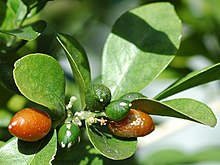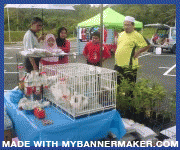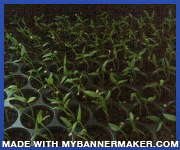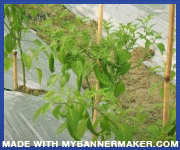Assalamualaikum....
Yang ni pulak pokok Bunga Murraya, satu lagi pokok bunga yang terwangi dan terlebat bunganya kat mini nursery den. Tapi pokok ibu ni den tak juallah....sayang wooo....mana taknya, den bela dia dari togel dah nak dibuang...hingga jadi penyeri dan pewangi nursery yang terbaik.. Ni pun masalah nak load gambor......kes sama laah cam tadi, kabel tertinggal kek opis... angin tul.... Nantilah Jumaat nanti den upload gambornya.
Pokok Murraya ni den jual dalam Rm 12 sepokok bagi sepasu anaknya.
Dan ini petikan dari Wikipedia berkenaan Pokok Murraya.
Murraya paniculata
From Wikipedia, the free encyclopedia
"Orange Jessamine" redirects here. This can also refer to the Orange Cestrum (Cestrum aurantiacum).
"Orange Jessamine" redirects here. This can also refer to the Orange Cestrum (Cestrum aurantiacum).
| Murraya paniculata | |
|---|---|
 | |
Line drawing of Murraya paniculata, showing flowers and fruit | |
| Scientific classification | |
| Kingdom: | Plantae |
| (unranked): | Angiosperms |
| (unranked): | Eudicots |
| (unranked): | Rosids |
| Order: | Sapindales |
| Family: | Rutaceae |
| Genus: | Murraya |
| Species: | M. paniculata |
| Binomial name | |
| Murraya paniculata (L.) Jack | |
Murraya paniculata, commonly called Orange Jessamine, is a tropical, evergreen plant bearing small, white, scented flowers, which is grown as an ornamental tree or hedge. Murraya is closely related to Citrus, and bears small orange to red fruit resembling kumquats, though some cultivars do not set fruit.
Taxonomical synonyms for M. paniculata are:
- Chalcas exotica (L.) Millsp
- Chalcas paniculata L. (basionym)
- Murraya exotica L.
Some of the common names include
Orange Jessamine, Chinese box, mock orange, Mock lime, satinwood ,[1] or Lakeview Jasmine (mainly in Florida)
- Bengali: কামিনী
- Khmer: Sarika Keo
- Hindi: Kamini (कामिनी)[2]
- Indonesian: Kemuning
- Kannada: Kadu karibevu[2]
- Malay: Kemuning
- Malayalam: Maramulla [2]
- Manipuri: Kamini kusum [2]
- Marathi: Kunti (कुन्ती)[2]
- Mandarin Chinese: 月橘 (Pinyin: yué jú "moon tangerine")
- Malaysian Fujian Chinese : 七里香[Chit Li Heong meaning "fragant can be smell seven li (li = 1/3 of a mile)]
- Tagalog: Kamuning
- Telugu: Nagagolungu[2]
- Tamil: Kattu Kariyilai or Vengarai (வெங்காரை)[2]
- Thai: แก้ว [kɛ̂ːw]
- Vietnamese: Nguyệt quất, Nguyệt quới
Description
Orange Jessamine is a small, tropical, evergreen tree or shrub growing up to 7 m tall. The plant flowers throughout the year. Its leaves are glabrous and glossy, occurring in 3-7 oddly pinnate leaflets which are elliptic to cuneate-obovate to rhombic. Flowers are terminal, corymbose, few-flowered, dense and fragrant. Petals are 12–18 mm long, recurved and white (or fading cream). The fruit of Murraya paniculata is fleshy, oblong-ovoid, coloured red to orange,[3] and grows up to 1 inch in length.[4]
Range
M. paniculata is a native of South and Southeast Asia, China and Australasia. It is naturalised in southern USA.[1]Uses
Traditionally, Murraya paniculata is used both in traditional medicine as an analgesic and for wood (for tool handles).
In the West, Murraya paniculata is cultured as an ornamental tree or hedge because of its hardiness, wide range of soil tolerance (M. paniculata may grow in alkaline, clayey, sandy, acidic and loamy soils), and is suitable for larger hedges. The plant flowers throughout the years and produces small, fragrant flower clusters which attract bees, while the fruits attract small frugivorous birds.[4]
Honey Bee farms have been known to plant Orange Jasmine near bee hives. Serving not only as food for the bees but as protection from harsh winds. Honey collected from bee hive colonies that collect pollen from orange jasmines, have a tangy sweet orange undertone. Alternatives for outdoor growth in colder climates would be a Gardenia bush.
Propagation
The Orange Jessamine is sexually propagated by its seeds. The fruits are eaten by birds, who then pass the seeds out in their stool. It may also be artificially propagated by softwood cuttings.[4]
Diseases
M. paniculata is the preferred host to the insect pest Diaphorina citri, the citrus psyllid. This psyllid is the vector for the citrus greening disease.[5]
Potential medicinal uses
The crude ethanolic extract of leaves of Murraya paniculata has antidiarrhoeal, antinociceptive [6] and anti-inflammatory activities.[7] Yuehchukene, a dimeric indole alkaloid, can be extracted from the root.
Notes and references
| Wikispecies has information related to: Murraya paniculata |
| Wikimedia Commons has media related to Murraya paniculata. |
Footnotes
- ^ Jump up to: a b http://www.ars-grin.gov/cgi-bin/npgs/html/tax_search.pl?Murraya%20paniculata retrieved on 28 June 2007
- ^ Jump up to: a b c d e f g http://www.flowersofindia.net/catalog/slides/Kamini.html
- Jump up ^ Welsh, 1998; pp 256
- ^ Jump up to: a b c d Gilman, Edward F. Factsheet FPS-416, October 1999; University of Florida Cooperative Extension Service, Institute of Food and Agricultural Sciences; from http://www.coralsprings.org/environment/SmallTreeList/pdf/MURPANA.pdf retrieved on 28 June 2007
- Jump up ^ http://www.hear.org/pier/species/murraya_paniculata.htm retrieved on 28 June 2007
- Jump up ^ "Antinociceptive and bioactivity of leaves of Murraya paniculata (L.) Jack, Rutaceae. Sharker S.Md., Shahid I.J., Hasanuzzaman Md. Brazilian Journal of Pharmacognosy. 19 (3) (pp 746-748), 2009.
- Jump up ^ Rahman M.A., Hasanuzzaman M., Uddin N., Shahid I.Z.,Antidiarrhoeal and anti-inflammatory activities of Murraya paniculata (L.) Jack." Pharmacologyonline. 3 (pp 768-776), 2010.
References
- Welsh, S. L. 1998. Flora Societensis: A summary revision of the flowering plants of the Society Islands E.P.S. Inc., Orem, Utah.



























